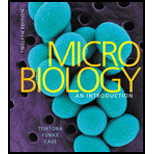
Microbiology: An Introduction
12th Edition
ISBN: 9780321929150
Author: Gerard J. Tortora, Berdell R. Funke, Christine L. Case
Publisher: PEARSON
expand_more
expand_more
format_list_bulleted
Textbook Question
Chapter 4, Problem 2R
Endospore formation is called (a) _____. It is initiated by (b) _____. Formation of a new cell from an endospore is called (c) _____. This process is triggered by (d) _____.
Expert Solution & Answer
Learn your wayIncludes step-by-step video

schedule01:48
Students have asked these similar questions
Briefly state the physical meaning of the electrocapillary equation (Lippman equation).
Explain in a small summary how:
What genetic information can be obtained from a Punnet square? What genetic information cannot be determined from a Punnet square?
Why might a Punnet Square be beneficial to understanding genetics/inheritance?
In a small summary write down:
Chapter 4 Solutions
Microbiology: An Introduction
Ch. 4 - DRAW IT Diagram each of the following flagellar...Ch. 4 - Endospore formation is called (a) _____. It is...Ch. 4 - DRAW IT Draw the bacterial shapes listed in (a),...Ch. 4 - Match the structures in column A to their...Ch. 4 - Why is an endospore called a resting structure? Of...Ch. 4 - Compare and contrast the following a. simple...Ch. 4 - Prob. 7RCh. 4 - Starch is readily metabolized by many cells, but a...Ch. 4 - Match the characteristics of eukaryotic cells in...Ch. 4 - NAME IT What group of microbes is characterized by...
Ch. 4 - Which of the following is not a distinguishing...Ch. 4 - Which statement best describes what happens when a...Ch. 4 - Which statement best describes what happens when a...Ch. 4 - Which statement best describes what happens when a...Ch. 4 - Which of the following statements best describes...Ch. 4 - Which of the following is false about fimbriae? a....Ch. 4 - Which of the following pairs is mismatched? a....Ch. 4 - Which of the following pairs is mismatched? a....Ch. 4 - You have isolated a motile, gram-positive cell...Ch. 4 - The antibiotic amphothericin B disrupts plasma...Ch. 4 - How can prokaryotic cells be smaller than...Ch. 4 - The smallest eukaryotic cell is the motile alga...Ch. 4 - Two types of prokaryotic cells have been...Ch. 4 - In 1985, a 0.5-mm cell was discovered in...Ch. 4 - When E. coli cells are exposed to a hypertonic...Ch. 4 - Clostridium botulinum is a strict anaerobe; that...Ch. 4 - A South San Francisco child enjoyed bath time at...Ch. 4 - Live cultures of Bacillus thuringiensis (Dipel)...
Additional Science Textbook Solutions
Find more solutions based on key concepts
Contrast the fertility of an allotetraploid with an autotriploid and an autotetraploid.
Concepts of Genetics (12th Edition)
Fibrous connective tissue consists of ground substance and fibers that provide strength, support, and flexibili...
Human Biology: Concepts and Current Issues (8th Edition)
40. Use the Lewis model to determine the formula for the compound that forms from each pair of atoms.
a. Al and...
Introductory Chemistry (6th Edition)
Police Captain Jeffers has suffered a myocardial infarction. a. Explain to his (nonmedically oriented) family w...
Human Physiology: An Integrated Approach (8th Edition)
Which type of cartilage is most plentiful in the adult body?
Anatomy & Physiology (6th Edition)
1. Why is the quantum-mechanical model of the atom important for understanding chemistry?
Chemistry: Structure and Properties (2nd Edition)
Knowledge Booster
Learn more about
Need a deep-dive on the concept behind this application? Look no further. Learn more about this topic, biology and related others by exploring similar questions and additional content below.Similar questions
- Not part of a graded assignment, from a past midtermarrow_forwardNoggin mutation: The mouse, one of the phenotypic consequences of Noggin mutationis mispatterning of the spinal cord, in the posterior region of the mouse embryo, suchthat in the hindlimb region the more ventral fates are lost, and the dorsal Pax3 domain isexpanded. (this experiment is not in the lectures).a. Hypothesis for why: What would be your hypothesis for why the ventral fatesare lost and dorsal fates expanded? Include in your answer the words notochord,BMP, SHH and either (or both of) surface ectoderm or lateral plate mesodermarrow_forwardNot part of a graded assignment, from a past midtermarrow_forward
- Explain in a flowcharts organazing the words down below: genetics Chromosomes Inheritance DNA & Genes Mutations Proteinsarrow_forwardplease helparrow_forwardWhat does the heavy dark line along collecting duct tell us about water reabsorption in this individual at this time? What does the heavy dark line along collecting duct tell us about ADH secretion in this individual at this time?arrow_forward
arrow_back_ios
SEE MORE QUESTIONS
arrow_forward_ios
Recommended textbooks for you
- Basic Clinical Lab Competencies for Respiratory C...NursingISBN:9781285244662Author:WhitePublisher:Cengage
 Concepts of BiologyBiologyISBN:9781938168116Author:Samantha Fowler, Rebecca Roush, James WisePublisher:OpenStax College
Concepts of BiologyBiologyISBN:9781938168116Author:Samantha Fowler, Rebecca Roush, James WisePublisher:OpenStax College  Comprehensive Medical Assisting: Administrative a...NursingISBN:9781305964792Author:Wilburta Q. Lindh, Carol D. Tamparo, Barbara M. Dahl, Julie Morris, Cindy CorreaPublisher:Cengage Learning
Comprehensive Medical Assisting: Administrative a...NursingISBN:9781305964792Author:Wilburta Q. Lindh, Carol D. Tamparo, Barbara M. Dahl, Julie Morris, Cindy CorreaPublisher:Cengage Learning Biology: The Dynamic Science (MindTap Course List)BiologyISBN:9781305389892Author:Peter J. Russell, Paul E. Hertz, Beverly McMillanPublisher:Cengage LearningEssentials Health Info Management Principles/Prac...Health & NutritionISBN:9780357191651Author:BowiePublisher:Cengage
Biology: The Dynamic Science (MindTap Course List)BiologyISBN:9781305389892Author:Peter J. Russell, Paul E. Hertz, Beverly McMillanPublisher:Cengage LearningEssentials Health Info Management Principles/Prac...Health & NutritionISBN:9780357191651Author:BowiePublisher:Cengage

Basic Clinical Lab Competencies for Respiratory C...
Nursing
ISBN:9781285244662
Author:White
Publisher:Cengage

Concepts of Biology
Biology
ISBN:9781938168116
Author:Samantha Fowler, Rebecca Roush, James Wise
Publisher:OpenStax College


Comprehensive Medical Assisting: Administrative a...
Nursing
ISBN:9781305964792
Author:Wilburta Q. Lindh, Carol D. Tamparo, Barbara M. Dahl, Julie Morris, Cindy Correa
Publisher:Cengage Learning

Biology: The Dynamic Science (MindTap Course List)
Biology
ISBN:9781305389892
Author:Peter J. Russell, Paul E. Hertz, Beverly McMillan
Publisher:Cengage Learning

Essentials Health Info Management Principles/Prac...
Health & Nutrition
ISBN:9780357191651
Author:Bowie
Publisher:Cengage
Prokaryotic vs. Eukaryotic Cells (Updated); Author: Amoeba Sisters;https://www.youtube.com/watch?v=Pxujitlv8wc;License: Standard youtube license